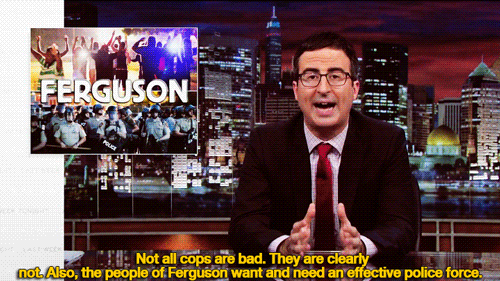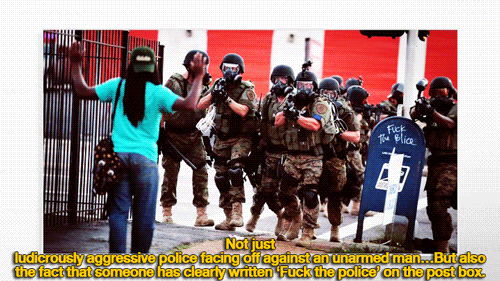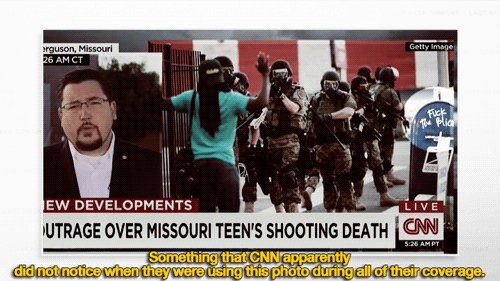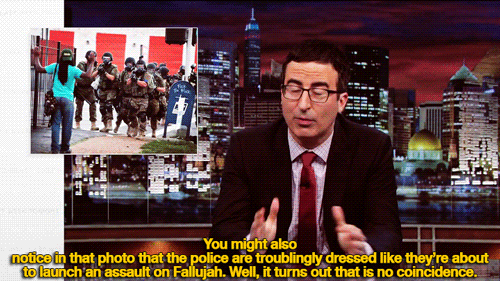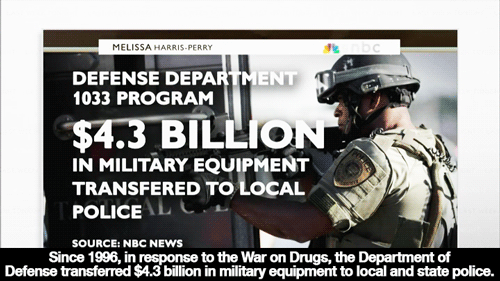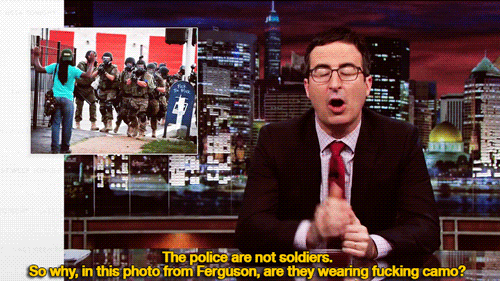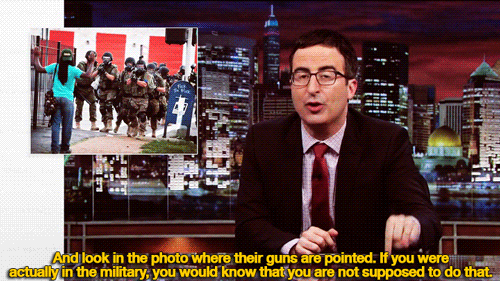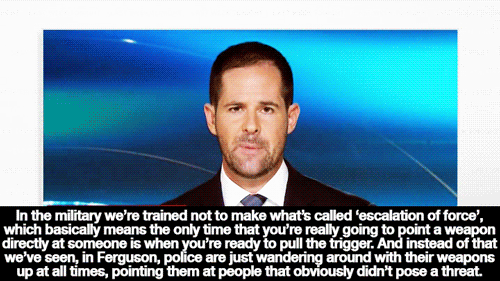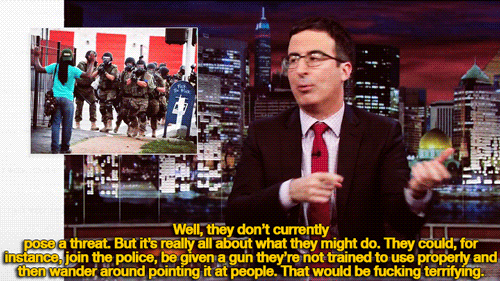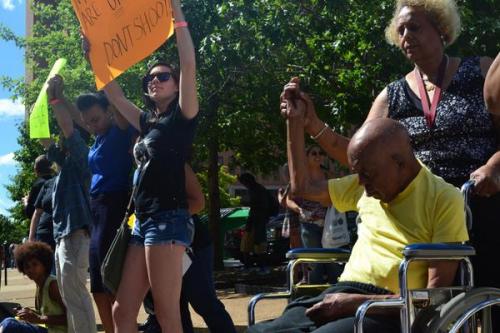Because important events are still happening there. In fact, a protest is going on today, September 10, 2014. The protest will shut down part of Highway 70 beginning at 3pm to protest the lack of a special prosecutor on the Michael Brown court case:
Long-time St. Louis activist Anthony Shahid will lead protesters across Interstate 70 today, shutting down the highway to protest the lack of a special prosecutor on the Michael Brown court case.
Protesters plan to meet at 3 p.m. at Hanley Road and then block the highway.
“It is going to cause people some discomfort, it is going to cause inconvenience to people,” says Eric Vickers, one of the organizers of the Justice for Michael Brown Leadership Coalition, about the highway protest. “That is a small price to pay to change the conditions for African American youth, and it is a very small price to pay to bring justice to Michael Brown. The Wednesday civil-disobedience action will be the start of a direct action campaign that will continue and will escalate until our demands are met.”
St. Louis Prosecuting Attorney Bob McCullough, who is currently handling the local criminal prosecution of Darren Wilson, the Ferguson Police officer who shot and killed Brown in August, has refused to step down from the case despite repeated calls from Ferguson protesters for his removal. Now that Governor Jay Nixon has called off the state of emergency in Ferguson, he has no authority to name a new prosecutor in the Brown case.
But that hasn’t stopped protesters, especially the newly formed Don’t Shoot Coalition, from demanding a new prosecutor. Many have questioned McCullough’s objectivity since his father, a police officer, was killed in the line of duty by a black man when McCullough was twelve years old.
No End in Sight for Darren Wilson Case as Grand Jury Term Officially Ends Wednesday
A grand jury has been considering evidence for three weeks now in the case of Ferguson police officer Darren Wilson, and the hearings will likely continue for at least another month despite the official term for the jury ending tomorrow.
Ed Magee, spokesman for the St. Louis County Prosecutor’s Office, tells Daily RFT that the grand jury will proceed to meet in special session after its four-month term ends Wednesday. Last month, St. Louis County Prosecutor Bob McCulloch estimated that the grand jury would weigh evidence surrounding the August 9 shooting death of eighteen-year-old Michael Brown through mid-October. Today Magee suggested that that timeline might be optimistic.”The process won’t be concluded until next month at the earliest,” says Magee.
During its special session, the grand jury will only review the Wilson case. Jurists had been meeting on Wednesdays during its official term on the grand jury but that could change under the special session.
“There are twelve of them, so the meetings will probably be held at different dates and times to accommodate their schedules,” says Magee.
Yesterday the Washington Post reported that unlike most criminal cases, prosecutors are not telling the grand jury what charges they think Wilson should face. Instead, the prosecutor’s office is presenting evidence to the jurists as it receives it, allowing the grand jury to consider all the photos, videos, testimonies, ballistics and other details involved in the investigation. Such a process greatly adds to the time the grand jury convenes but is also viewed as a more transparent way of presenting evidence in high-profile crimes. After the hearings conclude, the grand jury will help determine what charges to bring against Wilson — if any.
Magee tells Daily RFT that the only grand jury in recent history to convene as long as the Wilson case was in 2000 when two undercover officers shot and killed two suspects in a drug sting at a north county Jack in the Box. In that case, which carried many of the same racial overtones and public outcry as the Michael Brown shooting, the grand jury declined to indict the officers.
Why did Michael Brown’s body lay on the ground so long following his murder?
After Michael Brown was fatally shot by a police officer near his grandmother’s apartment complex, his body stayed in the street — sometime covered, sometimes not — for about four hours.
Photos of the body spread rapidly on social media, fueling the anger of a crowd already distraught at the death of an unarmed black teenager. Weeks later, many point to the delay in moving Brown’s body as the first sign of police breaking trust and mishandling the case. Even Ferguson Police Chief Tom Jackson told reporters he was uncomfortable with the long wait before Brown was transported to a nearby morgue.
So what took so long?
Jackson responded that “gun shots” nearby delayed investigators on scene, and St. Louis County Police Chief Jon Belmar pointed to the complexity of the investigation into Brown’s death at the hands of an officer.
“This is a very complicated investigation, as it should be,” Belmar said. “We need to make sure this investigation is done right.”
But to get the whole story, you have to hear from Calvin Whitaker, the man responsible for moving Brown’s body. Whitaker, a funeral director who handles moving bodies for St. Louis County, explained his side of the story to John Pertzborn on Fox2Now.
Police called Whitaker and his wife, who is also a funeral director, to pick up Brown’s body at 2:01 p.m., two hours after Ferguson Police Officer shot Brown. Whitaker arrived at 2:25 p.m. to find a tumultuous, angry crowd.
“It was very hectic, you could cut the tension with a knife,” Whitaker tells Fox2Now. “Police could not control the crowd.”
At one point, Whitaker heard gunshots nearby, just as Jackson told reporters in the days after Brown’s shooting. Whitaker and his wife don’t carry bullet-proof vests, so police told them to “hunker down” in their car to keep safe.
“There were times when we feared for our lives,” Whitaker says. He and his wife stayed in the car for two hours waiting for police to control the crowd. “It took so long because we could not do our job. It was unsafe for us to be there…There was nowhere for us to go.”
The only thing that could calm the crowd down long enough for Whitaker to take Brown’s body away was a plea from Brown’s family. Whitaker says he remembers family members begging the crowd to step back, saying, “”They will not pickup my son, they are not safe.”
Michael Brown’s Family Demands Officer Arrest at Tense Ferguson City Council Meeting
There were several extremely tense moments last night at Greater Grace Church at the first Ferguson City Council meeting since the shooting death of Michael Brown one month ago. Police presence in the lobby of the church was heavy as attendees walked through metal detectors. The first time proceedings screeched to a halt amid shouting came after Mayor James Knowles announced that, per normal procedures, each speaker would be allowed three minutes of public comment, but no one on the council would answer questions.
Knowles did, however, receive tepid approval at the first reading of several bills designed to reform parts of the municipal code that, in the wake of the shooting, have been highlighted as unfair to the city’s minorities and working poor. But as the public comment period began (the “fill out a comment card” system falling apart almost immediately), it was clear many in the audience felt the new bills were just platitudes.
“We’re not going to let you go back to business as usual,” said local activist Ashley Yates. “We’re going to hold you accountable. How many police officers have been let go? We’re gonna make sure they all get let go.”
The bills read last night would repeal an automatic fee for having a vehicle towed, toss out certain fees for municipal court cases, limit to 15 percent the amount of money the city’s general fund can receive from court fines and make a failure to appear in municipal court no longer a separate offense. Knowles also announced a bill for the formation of a citizen review board as well as an outstanding warrant recall program set for September 15 to October 15. Much of what Knowles said on these items was read from the same statement announcing the changes from the day prior — read more about that here.
If the changes to the city law were meant as an apology, it was clearly too late for Terri Franks, the mother of twin seventeen-year-old boys who she says have been constantly pulled over since they got their licenses a year ago, swamping her with court fees.
“You make your money off of our backs,” she said. “I’m constantly coming to court for something as frivolous as a blinker not being on.”
Michael-John Voss, an attorney with the ArchCity Defenders, told Daily RFT that the changes the city is making are “great,” though they stopped far short of what he and his colleagues are asking the city to do: Grant total amnesty to Ferguson residents with nonviolent warrants and fines sitting on their records, these being mainly for traffic offenses.
“You can see the anger and resentment here,” said Voss. “[The city] has to divide the administration of justice from the desire to raise revenue…there has to be a real commitment to show it’s not about the money.”


